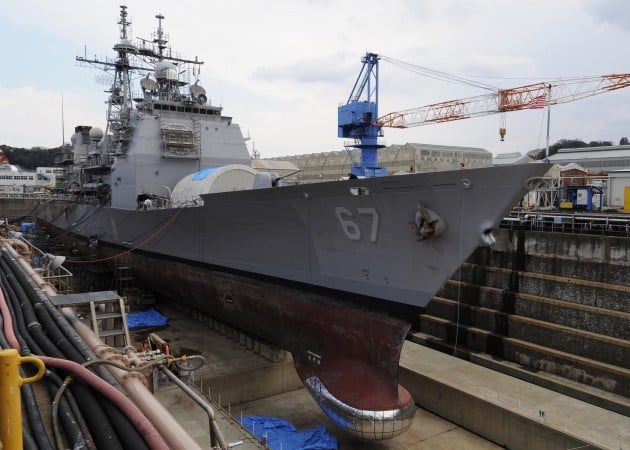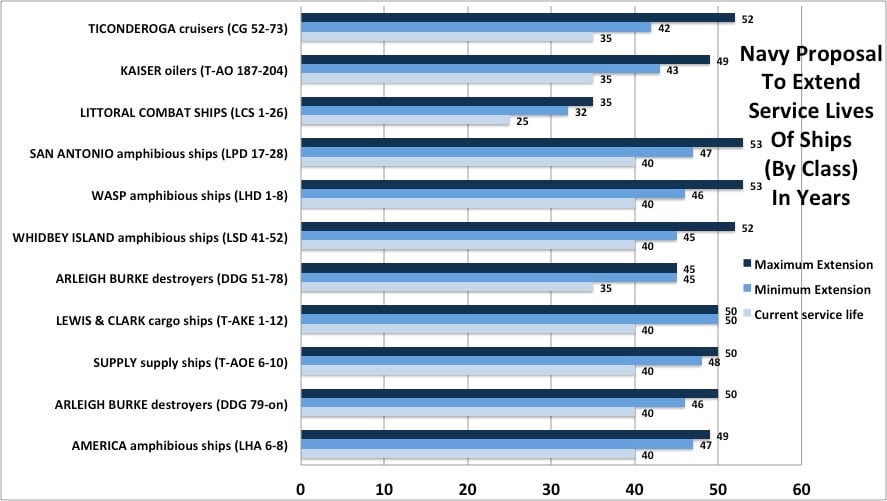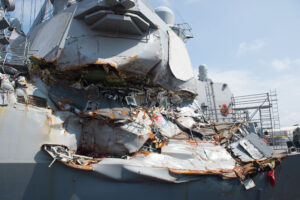
USS Shiloh, a Navy Aegis cruiser, in drydock for maintenance.
SAN DIEGO: If the Navy ever hopes to reach its goal of a 355-ship fleet, it won’t be by simply building new hulls and launching them. Instead, the admirals have long recognized they’ll have to extend the lives of dozens of ships already long in the tooth — and do so at a time when shipyard space is already stretched and less than half of its ships are able to complete scheduled maintenance on time.
“We’ve really got to get better than what we’re doing today,” Vice Adm. Tom Moore, head of Naval Sea Systems Command, told the West 2019 conference last week. “We’re digging out of a little bit of a maintenance backlog.” Moore and other commanders at the annual event insisted that they were getting better at getting ships in and out of maintenance availabilities, but currently only about 30 percent of destroyers are able to leave the docks on time.

A 2018 Navy proposal to keep ships in service longer. SOURCE: Naval Sea Systems Command (NAVSEA) (Click to expand)
The Navy is working on a plan to improve those numbers, but wholesale change in how the service schedules and contracts for repairs is needed. Key to that is private industry investing in more workers to meet the increasing demand. “We’ve got to make a concerted effort on both the public side and the private sector side to work with industry if we expect to get better,” Moore said. “If we don’t solve that piece, at the end of the day, we’re really not going to deliver the force to the combatant commanders that they need.”
Speaking to reporters after his talk, Moore delved deeper into what it’s going to take to move the needle and get ships in and out of repair availabilities on a more predictable schedule. The Navy has taken steps to increase the capacity of shipyards, and is working on ways to change the acquisition strategy to work with private shipyards to get even more capacity. Moore said that over the next six months, “you’ll see some real sea changes in how we’re going to contract for surface ship maintenance for the private sector that will incentivize them to build more capacity.”
Shipyards and companies in the private sector hire workers for specific projects, but the Navy usually issues a contract just a few months before a ship pulls in for work on a one-off contract, it doesn’t provide the shipyards an incentive to think long-term.
“Industry has got to hire more,” Moore said. “We got to build a system that incentivizes industry to have the right people there, so I think you’re going to see a real sea change in the way we’re working to acquire repair work,” that will give industry a longer view of the maintenance schedule.
I asked Moore about the Navy’s push toward more secrecy as to when ships are coming and going, and the Dynamic Force Employment concept, which will see ships leave port, only to return early from a deployment, and then head out again at an unpredictable time. Won’t that cause havoc in the push for more predictability he had been talking about?
“Operations come first,” he said. “There are ways we can incorporate the thought process of dynamic force employment and still give industry enough predictability.” But he recognized that the model of predictable unpredictability may be tough to square with the push on the back end for more predictability. “It’s something that the maintenance community is going to have to wrestle with,” he conceded. “We’re going to have to think our way carefully though this.”
Another big change the Navy says it wants to pursue is in how it monitors the readiness of the force, which is tied closely to refit and repair. The failures of keeping a ship’s systems up and running was seen in the deadly collision of the USS Fitzgerald with a cargo ship in the Pacific in 2017, which killed seven sailors. We don’t know enough about the USS McCain collision to say with certainty that maintenance was key.
“We need some fundamental changes in how we approach readiness, how we generate it, analyze it, measure it, [and] integrate it,” Fleet Forces commander Adm. Christopher Grady said at the conference.
Grady mentioned the possibility of bringing a chief readiness officer to manage all this, as well as standing up a Fleet Analytics Office to crunch the data and do analysis. “We also need to assess whether we have a modern IT structure in place to support these efforts across the Navy’s readiness exercise,” he said, including AI and other automated tools to “accelerate our decision-making by suggesting decision options that might not have been aware if we had relied only on human actions alone.”
Neither Moore or Grady offered any specifics to indicate where their initiatives may be headed. But it’s clear that in the wake of the Fitzgerald and McCain tragedies, uncertainty over future defense budgets, and Navy CNO Richardson’s comments recently that he’s rethinking the 355-ship-feet goal, that the service’s top admirals are putting everything on the table.
Multi-ship amphib buy could net $900M in savings, say Navy, Marine Corps officials
Lawmakers gave the Navy authorities to ink a multi-ship amphib deal years ago, but the service has not utilized that power yet.



























